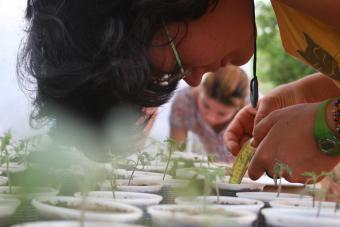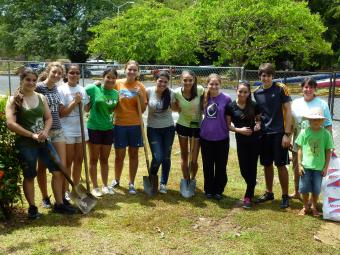A Garden for Nutre-Hogar
A Garden for Nutre-Hogar
The aid organisation Nutre Hogar was founded by Chaplain Rómulo Emiliani in 1988. Today all of 300 volunteers are helping to take care of malnourished children at an age between infancy and school enrollment in all of Panama. Depending on their state they keep the children anywhere between a month and a year, to then give them back to their families with advice on better nutrition.
In January of 2012 Kaya Berger, who has been studying in Germany for two years, returned to Panama. When she went to visit Balboa Academy, her high school in Panama City, she met her old biology teacher Karen Dertien. Together, they had lead Balboa’s Ecology Club for two years. Kaya was interested to know what the club was up to these days.
“Some students have gotten in touch with Nutre-Hogar”, says Karen while showing Kaya some tomato seedlings growing in the back of her classroom. “They want to start a huerto for the organization, a garden to help the home be more self sufficient.”
It was a great idea, but it didn’t seem to be taking off quite yet, nobody knew exactly how, when, where. Kaya’s green thumb was left itching. That same afternoon she met up with Sonia, the main social worker at Nurte Hogar, looked at the space available for the huerto and asked what exactly it was that they wanted. Kaya’s mind was set: during her time in Panama that garden was going to get started. This was followed by lots of back and forth e-mails between Kaya and Cristina, the vice president of the Ecology Club and advice from Señor Hojier, a retired man who gives advice on organic farming in the rural areas around Las Lajas and is Kaya’s supervisor when it comes to tropical gardening.
And so, a few weeks later, a hot Saturday at the end of March (ok, in Panama all Saturdays are hot), everything was ready to go. With gardening tools and a bag full of seeds, 15 motivated hobby-gardeners met in the garden of Nutre Hogar. It was time to dig into the sun-burned, clay-weighed dry season soil in order to plant tropical root-vegetables like yuca, ñame, ñampi and otoe, all from lo tuyo. In between the workers, Kaya’s little brother Luc (7), who is always happy when it comes to gardening, ran back and forth, spreading flower seeds everywhere - the garden is meant to be a demonstrative garden as well.
Part of the group watered the cuttings; others cut twigs off a pigeon pea bush and other leguminous plants to cover the freshly removed soil, to protect it from the burning heat of the sun and to fertilize the ground. Sonia was thrilled and agreed to collect compostable kitchen left over’s from now on to feed the plants.
At the beginning of May, when it starts to rain, mung beans will be seeded in between the plants to keep improving the soil, and in little flower beds herbs and Karen Dertien’s tomatoes will be planted.
“You know,” she said to Kaya, “everything you need in order to survive here you brought with you this morning in one bag. This is what should be done much more.”
How true is that, thought Kaya, happy with the successful day- and glad that her green thumb could now stop itching. Well, until tomorrow, at least.
Kaya Berger, 21, is the daughter of Silke Berger, who founded lo tuyo. Kaya is studying forestry and environmental sciences at the University of Freiburg, Germany. She is an active supporter of lo tuyo and there at the time, to work on her bachelors thesis about the organic cultivation of tomatoes in the tropics.



